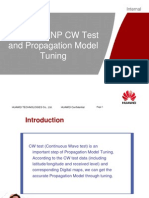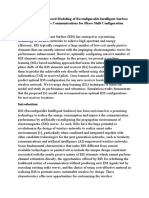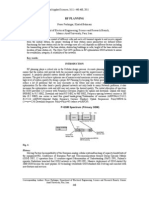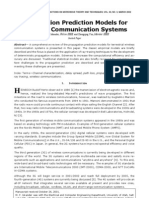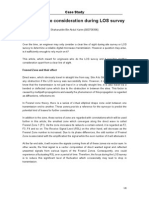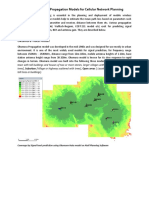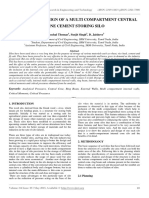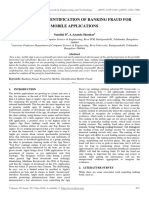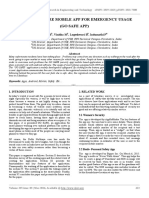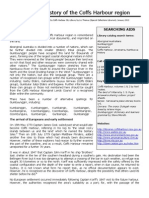Direction of Arrival Estimation Using Music Algorithm
Uploaded by
esatjournalsDirection of Arrival Estimation Using Music Algorithm
Uploaded by
esatjournalsIJRET: International Journal of Research in Engineering and Technology
eISSN: 2319-1163 | pISSN: 2321-7308
DIRECTION OF ARRIVAL ESTIMATION USING MUSIC ALGORITHM
Revati Joshi1, Ashwinikumar Dhande2
1
Student, E&Tc Department, Pune Institute of Computer Technology, Maharashtra, India
Professor, E&Tc Department, Pune Institute of Computer Technology, Maharashtra, India
Abstract
The performance of smart antenna greatly depends on the effectiveness of DOA estimation algorithm. This paper analyzed the
performance of MUSIC (Multiple Signal Classification) algorithm for DOA estimation. simulation results shows that MUSIC provide
better angular resolution for increasing number of array element, distance between array element and number of samples. All the
simulations are carried out using MATLAB.
Keywords: DOA (Direction of arrival), MUSIC (Multiple signal classification), ULA(Uniform linear array)
-----------------------------------------------------------------------***----------------------------------------------------------------------1. INTRODUCTION
The technique used for estimating the direction of
arrival(DOA) of radio signals in wireless system has received
considerable attention because estimating the direction of
arrival of several radio signals impinging on an array of
sensors is required in a variety of other applications, including
radar, sonar and seismology[1-2].
DOA estimation using a fixed antenna has many
disadvantages such as its resolution is limited by antennas
main lobe beam width [3].Antennas mainlobe beam width is
inversely proportional to physical size. Thus improving
accuracy of angle measurement by increasing physical size of
receiving antenna is not always a practical solution. certain
systems such as a missile seeker or aircraft antenna have
physical size limitation, therefore they provide wide main lobe
beam width. So that resolution is poor.
Instead of using a single antenna ,an array antenna system
with innovative signal processing can enhance the resolution
of signal DOA[4]. A array antenna has better performance in
signal reception and parameter estimation.
Fig-1:.DOA Estimation Parameter.
2. ARRAY SENSOR SYSTEM
The system consists of ULA with M antenna elements that are
linearly spaced along with equal distance.
As shown in fig.1 DOA estimation is depends on many
parameters such as number of mobile users, inter element
spacing, number of signals and spatial distribution.
There are many different super resolution algorithms such as
spectral estimation, model based and Eigen analysis [5]. In
this paper we concentrate on estimation of DOA using MUSIC
(Multiple signal classification) algorithm.
Fig.2: System model for DOA estimation using a uniform
linear array of M elements.
The M elements of ULA receives signals from a remote souce
i. The spacing between the elements should be half
wavelength of received signals. Suppose a plane wave signal
__________________________________________________________________________________________
Volume: 03 Issue: 03 | Mar-2014, Available @ http://www.ijret.org
633
IJRET: International Journal of Research in Engineering and Technology
generated by source i impinging on the array at an angle
and the signal generated by the source i is the ().If all the
signals generated by all the D sources, (),1<i<D,then total
signal and noise received by mth array element is given in
eqn1.
=
1 +
=1
() ,m=1
(1)
The equation 1 can be written as
0
1 (1 )] 1 +n(t)
1 ()
=As(t)+n(t)
(2)
=[a(
eISSN: 2319-1163 | pISSN: 2321-7308
of incident signals, direction of arrival (DOA) of each signal
strengths and cross correlation between incident signals and
noise power. It is assumed that noise in each channel is
uncorrelated. This leads to a diagonal covariance matrix.
The Algorithm starts with initializing some parameters such as
1. Number of antenna element=M.
2. Spacing between antenna element=.
3. Number of sources=1 , 2 . .
4. Incoming signal direction=1 , 2 . . .
5. Number of samples=K.
Using above data model, the input covariance matrix is given
in equation 8.
=
Where,
The data column vector received by the array is given in
equation 3.
= [1 , 1 , ()]
(3)
(4)
Substituting the value of eq.2 in eq.8 resultant expression for
can be obtain using eq.9
= + 2
(5)
These noise vector is having zero mean spatially uncorrelated
additive white noise and variance is equal to 2 .
The array steering column vector a( ) is defined in equation
6.
( ) = [1, , 2 , (1) ]
(6)
= [
(10)
2 is the noise covariance matrix is given in eq.11
(11)
I is M*M identity matrix.
By analyzing the properties of if numbers of antenna
elements are greater than the number of sources, then P is
positive definite i.e signal are not fully correlated.
The array covariance matrix can be estimated from received
snapshot vectors can be obtain using eq.12
The steering matrix is given in equation 7.
A=[a(1 , . . ( )
(9)
Where P is the covariance matrix of the signal vector is given
in eq.10
The noise vector generated by the sources is given in equation
5.
= [1 , 2 , ()]
(8)
Where E[.] is the expectation and (. ) is hermitian conjugate
transpose.
The signal column vector generated by the sources is given in
equation 4.
= [1 , 2 , ()]
(7)
=1
(12)
Where = - sin .is called spatial frequency for the ith
source that generates the signals of incident angle[6].
Where K is the number of snapshot
3. MUSIC ALGORITHM
Perform eigen decomposition of spatial correlation matrix
If( 0 , 1 , . 1 ) are eigen values of .
MUSIC is an acronym stands for Multiple Signal
Classification [7-8].It is proposed by Schmidt in 1979.The
basic idea behind the MUSIC algorithm is to separate the
signal from noise by using orthogonality property of their
spaces through eigen decomposition of the correlation matrix
of the received signal. It provides information about number
Solving for eigenvalue of is given in eq.13,14,15.
=0
(13)
__________________________________________________________________________________________
Volume: 03 Issue: 03 | Mar-2014, Available @ http://www.ijret.org
634
IJRET: International Journal of Research in Engineering and Technology
+ 2 = 0
(14)
+ ( 2 ) =0
4. SIMULATION RESULT
(15)
Therefore eigen values of are obtain using eq.16
= 2
(16)
As A contains steering vectors which are independent and full
column rank.and p is positive definite. Therefore eigenvalue
of AP are zero.M-D eigenvalue of are equal to the
noise variance 2 .sort the Eigen values of such that 0 is
the largest Eigen value, and 1 is the smallest Eigen value.
Therefore,
, 1.. 1 = 2
(17)
eISSN: 2319-1163 | pISSN: 2321-7308
The performance of MUSIC algorithm depends on following
parameters
1. Number of snapshots.
2. Number of array elements.
3. Element separation .
4.1 Effect of the Number of Snapshots on MUSIC
Algorithm.
As shown in Fig.(3) as number of snapshots(k=1000)
increases, MUSIC
can accurately estimate the DOA of
incident signals. This is because increase the number of
snapshots, will make narrower beam width around incident
signals directions. As shown in fig.(4) if number of snapshot
(k=10) then resolution of Music algorithm decreases.
(18)
The Eigen vector associated with a particular Eigen value,
is the vector such as given in eq.19
=
(19)
For Eigen vectors associated with M-D smallest Eigen values,
obtain using eq.20,21.
( 2 )= qi + 2 2 =0
qi = 0
(20)
Fig-3: MUSIC Spectrum using no of snapshot=1000
(21)
As A is full rank and P is non-singular, so that eq.21 becomes
qi = 0
(22)
This means that the Eigen vectors associated with the M-D
smallest Eigen values are orthogonal to the D steering vectors
that make up A.
{a(0 ) . . (1 )} {, . . 1 }
Fig-4: MUSIC Spectrum using no of snapshot=100.
To search the noise subspace, we form a matrix containing the
noise Eigen vectors.
4.2 Effect of the Number of Array Elements on
= [ +1 . . 1 ]
(23)
Since the steering vectors corresponding to signal components
are
orthogonal
to
the
noise
subspace
Eigen
vectors, () a()=0 for corresponding to the DOA of
a multipath component. Then the DOAs of the multiple
incident signals can be estimated by locating the peaks of a
MUSIC spatial spectrum which is given by eq.24
=
1
() a()
MUSIC Algorithm
As shown in Fig. (5) it is clear, that as number of array
elements increases, MUSIC can accurately estimate the DOA
of incident signals. And if number of array element (N=4)
decreases, then resolution of Music algorithm decreases. It is
shown in Fig (6).
(24)
__________________________________________________________________________________________
Volume: 03 Issue: 03 | Mar-2014, Available @ http://www.ijret.org
635
IJRET: International Journal of Research in Engineering and Technology
eISSN: 2319-1163 | pISSN: 2321-7308
5. CONCLUSIONS
The simulation result of Music algorithm shows that angular
resolution of Music algorithm improves with more no. of
elements in the array, with large snapshot of signals and
greater angular separation between the signals. MUSIC can
estimate uncorrelated signal very well but it fails to detect
correlated signals.
Fig-.5: MUSIC Spectrum using no of array element=8.
Fig-6:.MUSIC Spectrum using no of array element=4.
4.3 Effect of the Varying Element Separation on
MUSIC Algorithm
From Fig. (7) it is clear, that as the distance between array
elements increases, MUSIC can accurately estimate the DOA
of incident signals. And fig.(8) shows that, if distance between
array element is (d=0.4) decreases, then resolution of Music
algorithm is decreases.
REFERENCES
[1]. S.U.Pillai, Array Signal Processing, Springer-Verlag,
1989.
[2]. M. Brandstein and D. Ward, Eds., Microphone Arrays,
Springer, 2001.
[3]. Marshall M.Grice, Direction of arrival estimation using
superresolution algorithms.M Sc. Thesis, California State
Polytechnic University, Pomona, 2007.
[4]. Zekeriya Aliyazicioglu, H.K. Hwang. Marshall Grice,
AnatolyYakovlev, Sensitivity analysis for direction of arrival
estimation using a Root-MUSIC algorithm, Proceedings of
the International MultiConference of Engineers and Computer
Scientists Vol II IMECS, 19-21 March 2008
[5]. Don H. Johnson, Dan E. Dudgeon, Array signal
processing concepts and techniques, P T R Prentice Hall Inc,
A Division of Simon & Schuster Englewood Cliffs, New
Jersey 07632, 1993.
[6]. Z. Chen, G. Gokeda, and Y. Yu, Introduction to
Direction-of-Arrival Estimation, Artech House, vol. 34, no.
37, pp. 46-47, 2010
[7]. MUSIC Algorithm by Brian L. Evans, 211-105 Cory Hall,
Berkeley, CA 94720-1772.
[8]. A.Majdoubi., M.Essaaidi, The Estimation of DOA in
Smart Antenna System, International Journal of Innovative
Technology and Exploring Engineering, Vol.1, Issue6,
Nov.2013.
Fig-7: MUSIC Spectrum using element separation d=0.5.
Fig-8: MUSIC Spectrum using element separation d=0.5.
__________________________________________________________________________________________
Volume: 03 Issue: 03 | Mar-2014, Available @ http://www.ijret.org
636
You might also like
- Award Lte Radio Network Planning and DesignNo ratings yetAward Lte Radio Network Planning and Design1 page
- A Telecom & IT Company: Netwing Technologies Pvt. LTD100% (1)A Telecom & IT Company: Netwing Technologies Pvt. LTD37 pages
- XXXX Project Microwave Quality Inspection Report V2.1No ratings yetXXXX Project Microwave Quality Inspection Report V2.124 pages
- IMaster NCE V100R019C00 Product Description (ARM) 15No ratings yetIMaster NCE V100R019C00 Product Description (ARM) 15844 pages
- 02 WCDMA RNP CW Test and Propagation Model TuningNo ratings yet02 WCDMA RNP CW Test and Propagation Model Tuning64 pages
- RIS-Aided Cell-Free Massive MIMO: Performance Analysis and CompetitivenessNo ratings yetRIS-Aided Cell-Free Massive MIMO: Performance Analysis and Competitiveness6 pages
- A Deep Learning Based Modeling of Reconfigurable Intelligent Surface Assisted Wireless Communications For Phase Shift ConfigurationNo ratings yetA Deep Learning Based Modeling of Reconfigurable Intelligent Surface Assisted Wireless Communications For Phase Shift Configuration9 pages
- Huawei GENEX Series Introduction To GENEX Assistant (Ver 1.4)No ratings yetHuawei GENEX Series Introduction To GENEX Assistant (Ver 1.4)55 pages
- Naser Parhizgar, Khaled Bahmani Department of Electrical Engineering, Science and Research Branch, Islamic Azad University, Fars, IranNo ratings yetNaser Parhizgar, Khaled Bahmani Department of Electrical Engineering, Science and Research Branch, Islamic Azad University, Fars, Iran21 pages
- Propagation Prediction Models For Wireless Communication SystemNo ratings yetPropagation Prediction Models For Wireless Communication System21 pages
- Fresnel Zone Consideration During LOS SurveyNo ratings yetFresnel Zone Consideration During LOS Survey6 pages
- Chau Yuen, Reconfigurable Intelligent Surface PresentationNo ratings yetChau Yuen, Reconfigurable Intelligent Surface Presentation34 pages
- Introduction To Space-Time Codes: Sumeet Sandhu Rohit NabarNo ratings yetIntroduction To Space-Time Codes: Sumeet Sandhu Rohit Nabar33 pages
- Training On RF Optimisation GSM: Network EngineeringNo ratings yetTraining On RF Optimisation GSM: Network Engineering186 pages
- Review of Radio Propagation Models For Cellular Network PlanningNo ratings yetReview of Radio Propagation Models For Cellular Network Planning2 pages
- What Is LTE?: 3G WCDMA (R99) 3.5G HSPA LTENo ratings yetWhat Is LTE?: 3G WCDMA (R99) 3.5G HSPA LTE20 pages
- LS Brochure Spectrum Management System Solutions For Radio Spectrum Management and Network Planning and EngineeringNo ratings yetLS Brochure Spectrum Management System Solutions For Radio Spectrum Management and Network Planning and Engineering16 pages
- WCDMA RNO Special Guide Coverage Problem Analysis-20050316-A-2.0100% (1)WCDMA RNO Special Guide Coverage Problem Analysis-20050316-A-2.036 pages
- Basic Electronic Interview Questions and AnswersNo ratings yetBasic Electronic Interview Questions and Answers18 pages
- Chapter 3 Antenna Arrays and Beamforming Array Beam Forming TechniquesNo ratings yetChapter 3 Antenna Arrays and Beamforming Array Beam Forming Techniques24 pages
- WCDMA RAN Planning and Optimization (Book1 WRNPO Basics)100% (1)WCDMA RAN Planning and Optimization (Book1 WRNPO Basics)283 pages
- Microwave Filters for Communication Systems: Fundamentals, Design, and ApplicationsFrom EverandMicrowave Filters for Communication Systems: Fundamentals, Design, and ApplicationsNo ratings yet
- Emerging Technologies in Information and Communications TechnologyFrom EverandEmerging Technologies in Information and Communications TechnologyNo ratings yet
- Optical and Microwave Technologies for Telecommunication NetworksFrom EverandOptical and Microwave Technologies for Telecommunication NetworksNo ratings yet
- PTT PoC push-to-talk over cellular A Clear and Concise ReferenceFrom EverandPTT PoC push-to-talk over cellular A Clear and Concise ReferenceNo ratings yet
- LTE Self-Organising Networks (SON): Network Management Automation for Operational EfficiencyFrom EverandLTE Self-Organising Networks (SON): Network Management Automation for Operational EfficiencySeppo HämäläinenNo ratings yet
- Radio Network Planning and Optimisation for UMTSFrom EverandRadio Network Planning and Optimisation for UMTSJaana Laiho4.5/5 (2)
- Wireless Sensor Networks: Technology, Protocols, and ApplicationsFrom EverandWireless Sensor Networks: Technology, Protocols, and ApplicationsNo ratings yet
- "The Future of Connectivity: Unleashing the Power of 5G and Beyond": GoodMan, #1From Everand"The Future of Connectivity: Unleashing the Power of 5G and Beyond": GoodMan, #1No ratings yet
- A Study and Survey On Various Progressive Duplicate Detection MechanismsNo ratings yetA Study and Survey On Various Progressive Duplicate Detection Mechanisms3 pages
- Analysis and Optimization of Electrodes For Improving The Performance of Ring Laser Gyro PDFNo ratings yetAnalysis and Optimization of Electrodes For Improving The Performance of Ring Laser Gyro PDF4 pages
- Analysis and Design of A Multi Compartment Central Cone Cement Storing Silo PDFNo ratings yetAnalysis and Design of A Multi Compartment Central Cone Cement Storing Silo PDF7 pages
- Analysis of Cylindrical Shell Structure With Varying Parameters PDFNo ratings yetAnalysis of Cylindrical Shell Structure With Varying Parameters PDF6 pages
- A Review Paper On Smart Health Care System Using Internet of ThingsNo ratings yetA Review Paper On Smart Health Care System Using Internet of Things5 pages
- A Research On Significance of Kalman Filter-Approach As Applied in Electrical Power SystemNo ratings yetA Research On Significance of Kalman Filter-Approach As Applied in Electrical Power System8 pages
- A Servey On Wireless Mesh Networking ModuleNo ratings yetA Servey On Wireless Mesh Networking Module5 pages
- A Review Paper On Smart Health Care System Using Internet of ThingsNo ratings yetA Review Paper On Smart Health Care System Using Internet of Things5 pages
- A Servey On Wireless Mesh Networking ModuleNo ratings yetA Servey On Wireless Mesh Networking Module5 pages
- A Study and Survey On Various Progressive Duplicate Detection MechanismsNo ratings yetA Study and Survey On Various Progressive Duplicate Detection Mechanisms3 pages
- A Review On Fake Biometric Detection System For Various ApplicationsNo ratings yetA Review On Fake Biometric Detection System For Various Applications4 pages
- A Three-Level Disposal Site Selection Criteria System For Toxic and Hazardous Wastes in The PhilippinesNo ratings yetA Three-Level Disposal Site Selection Criteria System For Toxic and Hazardous Wastes in The Philippines9 pages
- Pushover Analysis-To Study Seismic Performances of Vertical Irregular Structure PDFNo ratings yetPushover Analysis-To Study Seismic Performances of Vertical Irregular Structure PDF4 pages
- A Survey On Identification of Ranking Fraud For Mobile ApplicationsNo ratings yetA Survey On Identification of Ranking Fraud For Mobile Applications6 pages
- A Research On Significance of Kalman Filter-Approach As Applied in Electrical Power SystemNo ratings yetA Research On Significance of Kalman Filter-Approach As Applied in Electrical Power System8 pages
- A Women Secure Mobile App For Emergency Usage (Go Safe App)No ratings yetA Women Secure Mobile App For Emergency Usage (Go Safe App)3 pages
- Power Generation Using Maglev Windmill PDFNo ratings yetPower Generation Using Maglev Windmill PDF6 pages
- Privacy Preserving Through Mediator in Decentralized Ciphertext Policy Attribute Based Encryption PDFNo ratings yetPrivacy Preserving Through Mediator in Decentralized Ciphertext Policy Attribute Based Encryption PDF6 pages
- Aboriginal History of The Coffs Harbour RegionNo ratings yetAboriginal History of The Coffs Harbour Region16 pages
- 2019 WhatisTV Redefining V4 TV MediArXiv PrePrintsNo ratings yet2019 WhatisTV Redefining V4 TV MediArXiv PrePrints26 pages
- A Telecom & IT Company: Netwing Technologies Pvt. LTDA Telecom & IT Company: Netwing Technologies Pvt. LTD
- XXXX Project Microwave Quality Inspection Report V2.1XXXX Project Microwave Quality Inspection Report V2.1
- IMaster NCE V100R019C00 Product Description (ARM) 15IMaster NCE V100R019C00 Product Description (ARM) 15
- RIS-Aided Cell-Free Massive MIMO: Performance Analysis and CompetitivenessRIS-Aided Cell-Free Massive MIMO: Performance Analysis and Competitiveness
- A Deep Learning Based Modeling of Reconfigurable Intelligent Surface Assisted Wireless Communications For Phase Shift ConfigurationA Deep Learning Based Modeling of Reconfigurable Intelligent Surface Assisted Wireless Communications For Phase Shift Configuration
- Huawei GENEX Series Introduction To GENEX Assistant (Ver 1.4)Huawei GENEX Series Introduction To GENEX Assistant (Ver 1.4)
- Naser Parhizgar, Khaled Bahmani Department of Electrical Engineering, Science and Research Branch, Islamic Azad University, Fars, IranNaser Parhizgar, Khaled Bahmani Department of Electrical Engineering, Science and Research Branch, Islamic Azad University, Fars, Iran
- Propagation Prediction Models For Wireless Communication SystemPropagation Prediction Models For Wireless Communication System
- Chau Yuen, Reconfigurable Intelligent Surface PresentationChau Yuen, Reconfigurable Intelligent Surface Presentation
- Introduction To Space-Time Codes: Sumeet Sandhu Rohit NabarIntroduction To Space-Time Codes: Sumeet Sandhu Rohit Nabar
- Training On RF Optimisation GSM: Network EngineeringTraining On RF Optimisation GSM: Network Engineering
- Review of Radio Propagation Models For Cellular Network PlanningReview of Radio Propagation Models For Cellular Network Planning
- LS Brochure Spectrum Management System Solutions For Radio Spectrum Management and Network Planning and EngineeringLS Brochure Spectrum Management System Solutions For Radio Spectrum Management and Network Planning and Engineering
- WCDMA RNO Special Guide Coverage Problem Analysis-20050316-A-2.0WCDMA RNO Special Guide Coverage Problem Analysis-20050316-A-2.0
- Chapter 3 Antenna Arrays and Beamforming Array Beam Forming TechniquesChapter 3 Antenna Arrays and Beamforming Array Beam Forming Techniques
- WCDMA RAN Planning and Optimization (Book1 WRNPO Basics)WCDMA RAN Planning and Optimization (Book1 WRNPO Basics)
- The IMS: IP Multimedia Concepts and ServicesFrom EverandThe IMS: IP Multimedia Concepts and Services
- Modulation and Coding Techniques in Wireless CommunicationsFrom EverandModulation and Coding Techniques in Wireless Communications
- Microwave Filters for Communication Systems: Fundamentals, Design, and ApplicationsFrom EverandMicrowave Filters for Communication Systems: Fundamentals, Design, and Applications
- Emerging Technologies in Information and Communications TechnologyFrom EverandEmerging Technologies in Information and Communications Technology
- New Telecom Networks: Enterprises and SecurityFrom EverandNew Telecom Networks: Enterprises and Security
- Optical and Microwave Technologies for Telecommunication NetworksFrom EverandOptical and Microwave Technologies for Telecommunication Networks
- PTT PoC push-to-talk over cellular A Clear and Concise ReferenceFrom EverandPTT PoC push-to-talk over cellular A Clear and Concise Reference
- LTE Self-Organising Networks (SON): Network Management Automation for Operational EfficiencyFrom EverandLTE Self-Organising Networks (SON): Network Management Automation for Operational Efficiency
- Drive testing The Ultimate Step-By-Step GuideFrom EverandDrive testing The Ultimate Step-By-Step Guide
- Radio Network Planning and Optimisation for UMTSFrom EverandRadio Network Planning and Optimisation for UMTS
- Wireless Sensor Networks: Technology, Protocols, and ApplicationsFrom EverandWireless Sensor Networks: Technology, Protocols, and Applications
- "The Future of Connectivity: Unleashing the Power of 5G and Beyond": GoodMan, #1From Everand"The Future of Connectivity: Unleashing the Power of 5G and Beyond": GoodMan, #1
- A Study and Survey On Various Progressive Duplicate Detection MechanismsA Study and Survey On Various Progressive Duplicate Detection Mechanisms
- Analysis and Optimization of Electrodes For Improving The Performance of Ring Laser Gyro PDFAnalysis and Optimization of Electrodes For Improving The Performance of Ring Laser Gyro PDF
- Analysis and Design of A Multi Compartment Central Cone Cement Storing Silo PDFAnalysis and Design of A Multi Compartment Central Cone Cement Storing Silo PDF
- Analysis of Cylindrical Shell Structure With Varying Parameters PDFAnalysis of Cylindrical Shell Structure With Varying Parameters PDF
- A Review Paper On Smart Health Care System Using Internet of ThingsA Review Paper On Smart Health Care System Using Internet of Things
- A Research On Significance of Kalman Filter-Approach As Applied in Electrical Power SystemA Research On Significance of Kalman Filter-Approach As Applied in Electrical Power System
- A Review Paper On Smart Health Care System Using Internet of ThingsA Review Paper On Smart Health Care System Using Internet of Things
- A Study and Survey On Various Progressive Duplicate Detection MechanismsA Study and Survey On Various Progressive Duplicate Detection Mechanisms
- A Review On Fake Biometric Detection System For Various ApplicationsA Review On Fake Biometric Detection System For Various Applications
- A Three-Level Disposal Site Selection Criteria System For Toxic and Hazardous Wastes in The PhilippinesA Three-Level Disposal Site Selection Criteria System For Toxic and Hazardous Wastes in The Philippines
- Pushover Analysis-To Study Seismic Performances of Vertical Irregular Structure PDFPushover Analysis-To Study Seismic Performances of Vertical Irregular Structure PDF
- A Survey On Identification of Ranking Fraud For Mobile ApplicationsA Survey On Identification of Ranking Fraud For Mobile Applications
- A Research On Significance of Kalman Filter-Approach As Applied in Electrical Power SystemA Research On Significance of Kalman Filter-Approach As Applied in Electrical Power System
- A Women Secure Mobile App For Emergency Usage (Go Safe App)A Women Secure Mobile App For Emergency Usage (Go Safe App)
- Privacy Preserving Through Mediator in Decentralized Ciphertext Policy Attribute Based Encryption PDFPrivacy Preserving Through Mediator in Decentralized Ciphertext Policy Attribute Based Encryption PDF
- 2019 WhatisTV Redefining V4 TV MediArXiv PrePrints2019 WhatisTV Redefining V4 TV MediArXiv PrePrints















